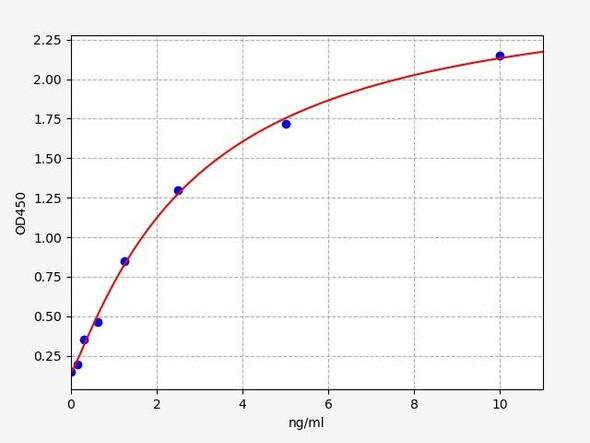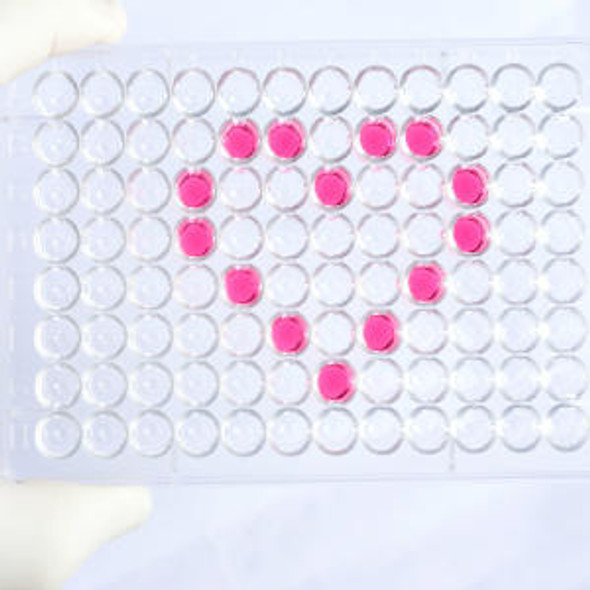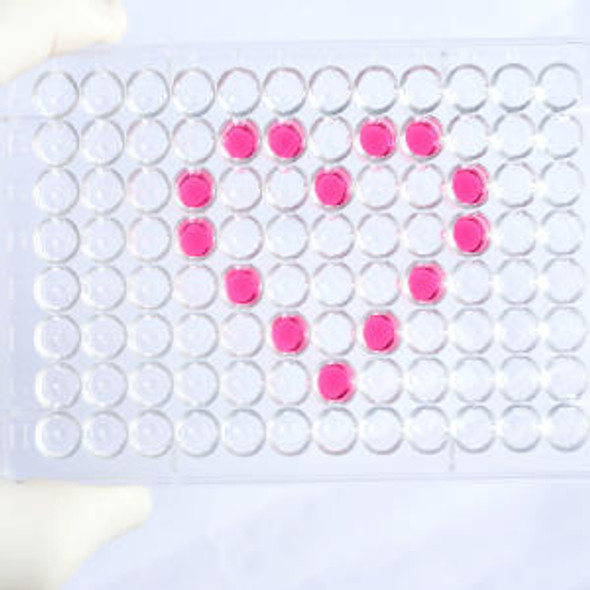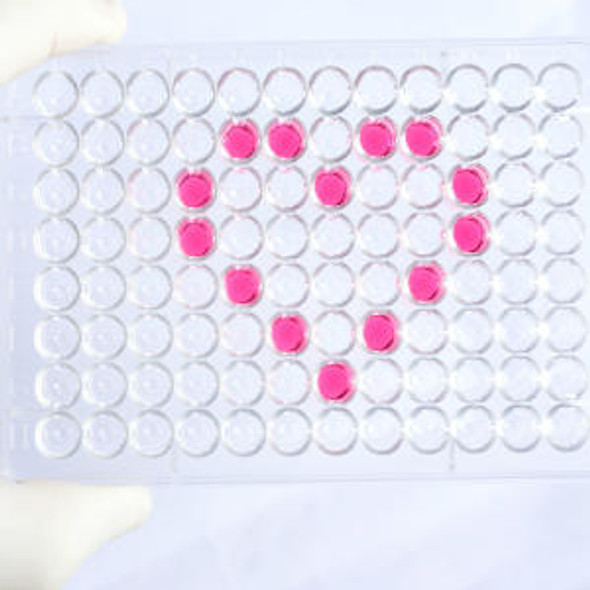Human E3 ubiquitin-protein ligase ELISA Kit
- SKU:
- HUFI01875
- Product Type:
- ELISA Kit
- Size:
- 96 Assays
- Uniprot:
- Q7Z6Z7
- Sensitivity:
- 0.094ng/ml
- Range:
- 0.156-10ng/ml
- ELISA Type:
- Sandwich
- Synonyms:
- HUWE1, Upstream regulatory element-binding protein 1, URE-B1, URE-binding protein 1, Mcl-1 ubiquitin ligase E3, Large structure of UREB1, LASU1, Homologous to E6AP carboxyl terminus homologous protein 9, HectH9, ARF-binding protein 1, ARF-BP1, HECT,
- Reactivity:
- Human
- Research Area:
- Cell Biology
Description
Human E3 ubiquitin-protein ligase ELISA
E3 ubiquitin-protein ligase encodes a protein containing a C-terminal HECT domain, which is required for the ubiquitination and subsequent degradation of the anti-apoptotic protein Mcl1. Mutations in E3 ubiquitin-protein ligase are associated with Turner type X-linked syndromic cognitive disability. The Assay Genie Human E3 ubiquitin-protein ligase ELISA is a highly sensitive assay for the quantitative measurement of E3 ubiquitin-protein ligase in serum, blood, plasma, cell culture supernatant and tissue samples.
| Product Name: | Human E3 ubiquitin-protein ligase ELISA Kit |
| Product Code: | HUFI01875 |
| Size: | 96 Assays |
| Alias: | HUWE1, Upstream regulatory element-binding protein 1, URE-B1, URE-binding protein 1, Mcl-1 ubiquitin ligase E3, Large structure of UREB1, LASU1, Homologous to E6AP carboxyl terminus homologous protein 9, HectH9, ARF-binding protein 1, ARF-BP1, HECT, UBA and WWE domain-containing protein 1 |
| Detection method: | Sandwich ELISA, Double Antibody |
| Application: | This immunoassay kit allows for the in vitro quantitative determination of Human HUWE1 concentrations in serum plasma and other biological fluids. |
| Sensitivity: | 0.094ng/ml |
| Range: | 0.156-10ng/ml |
| Storage: | 4°C for 6 months |
| Note: | For Research Use Only |
| Recovery: | Matrices listed below were spiked with certain level of Human HUWE1 and the recovery rates were calculated by comparing the measured value to the expected amount of Human HUWE1 in samples. | ||||||||||||||||
| |||||||||||||||||
| Linearity: | The linearity of the kit was assayed by testing samples spiked with appropriate concentration of Human HUWE1 and their serial dilutions. The results were demonstrated by the percentage of calculated concentration to the expected. | ||||||||||||||||
| |||||||||||||||||
| CV(%): | Intra-Assay: CV<8% Inter-Assay: CV<10% |
| Component | Quantity | Storage |
| ELISA Microplate (Dismountable) | 8×12 strips | 4°C for 6 months |
| Lyophilized Standard | 2 | 4°C/-20°C |
| Sample/Standard Dilution Buffer | 20ml | 4°C |
| Biotin-labeled Antibody(Concentrated) | 120ul | 4°C (Protect from light) |
| Antibody Dilution Buffer | 10ml | 4°C |
| HRP-Streptavidin Conjugate(SABC) | 120ul | 4°C (Protect from light) |
| SABC Dilution Buffer | 10ml | 4°C |
| TMB Substrate | 10ml | 4°C (Protect from light) |
| Stop Solution | 10ml | 4°C |
| Wash Buffer(25X) | 30ml | 4°C |
| Plate Sealer | 5 | - |
Other materials and equipment required:
- Microplate reader with 450 nm wavelength filter
- Multichannel Pipette, Pipette, microcentrifuge tubes and disposable pipette tips
- Incubator
- Deionized or distilled water
- Absorbent paper
- Buffer resevoir
| Uniprot | Q7Z6Z7 |
| UniProt Protein Function: | HUWE1: E3 ubiquitin-protein ligase which mediates ubiquitination and subsequent proteasomal degradation of target proteins. Regulates apoptosis by catalyzing the polyubiquitination and degradation of MCL1. Mediates monoubiquitination of DNA polymerase beta (POLB) at 'Lys-41', 'Lys-61' and 'Lys-81', thereby playing a role in base-excision repair. Also ubiquitinates the p53/TP53 tumor suppressor and core histones including H1, H2A, H2B, H3 and H4. Binds to an upstream initiator-like sequence in the preprodynorphin gene. Regulates neural differentiation and proliferation by catalyzing the polyubiquitination and degradation of MYCN. May regulate abundance of CDC6 after DNA damage by polyubiquitinating and targeting CDC6 to degradation. Interacts with isoform p14ARF of CDKN2A which strongly inhibits HUWE1 ubiquitin ligase activity. Interacts with MYCN, POLB and CDC6. Weakly expressed in heart, brain and placenta but not in other tissues. Expressed in a number of cell lines, predominantly in those from colorectal carcinomas. Belongs to the TOM1/PTR1 family. 3 isoforms of the human protein are produced by alternative splicing. |
| UniProt Protein Details: | Protein type:EC 6.3.2.19; Ubiquitin ligase; EC 6.3.2.-; Ligase; Ubiquitin conjugating system Chromosomal Location of Human Ortholog: Xp11.22 Cellular Component: cytoplasm; membrane; nucleoplasm; nucleus Molecular Function:DNA binding; ligase activity; protein binding; ubiquitin-protein ligase activity Biological Process: base-excision repair; cell differentiation; histone ubiquitination; protein monoubiquitination; protein polyubiquitination; protein ubiquitination during ubiquitin-dependent protein catabolic process Disease: Mental Retardation, X-linked, Syndromic, Turner Type |
| NCBI Summary: | This gene encodes a protein containing a C-terminal HECT (E6AP type E3 ubiquitin protein ligase) domain that functions as an E3 ubiquitin ligase. The encoded protein is required for the ubiquitination and subsequent degradation of the anti-apoptotic protein Mcl1 (myeloid cell leukemia sequence 1 (BCL2-related)). This protein also ubiquitinates the p53 tumor suppressor, core histones, and DNA polymerase beta. Mutations in this gene are associated with Turner type X-linked syndromic mental retardation. [provided by RefSeq, Aug 2013] |
| UniProt Code: | Q7Z6Z7 |
| NCBI GenInfo Identifier: | 61676188 |
| NCBI Gene ID: | 10075 |
| NCBI Accession: | NP_113584.3 |
| UniProt Secondary Accession: | Q7Z6Z7,O15029, Q4G2Z2, Q5H961, Q6P4D0, Q8NG67, Q9BUI0 Q9HCJ4, Q9NSL6, Q9P0A9, |
| UniProt Related Accession: | Q7Z6Z7 |
| Molecular Weight: | 481,018 Da |
| NCBI Full Name: | E3 ubiquitin-protein ligase HUWE1 |
| NCBI Synonym Full Names: | HECT, UBA and WWE domain containing 1, E3 ubiquitin protein ligase |
| NCBI Official Symbol: | HUWE1 |
| NCBI Official Synonym Symbols: | MULE; Ib772; LASU1; UREB1; HECTH9; URE-B1; ARF-BP1; HSPC272 |
| NCBI Protein Information: | E3 ubiquitin-protein ligase HUWE1 |
| UniProt Protein Name: | E3 ubiquitin-protein ligase HUWE1 |
| UniProt Synonym Protein Names: | ARF-binding protein 1; ARF-BP1; HECT, UBA and WWE domain-containing protein 1; Homologous to E6AP carboxyl terminus homologous protein 9; HectH9; Large structure of UREB1; LASU1; Mcl-1 ubiquitin ligase E3; Mule; Upstream regulatory element-binding protein 1; URE-B1; URE-binding protein 1 |
| Protein Family: | E3 ubiquitin-protein ligase |
| UniProt Gene Name: | HUWE1 |
| UniProt Entry Name: | HUWE1_HUMAN |
*Note: Protocols are specific to each batch/lot. For the correct instructions please follow the protocol included in your kit.
Before adding to wells, equilibrate the SABC working solution and TMB substrate for at least 30 min at 37°C. When diluting samples and reagents, they must be mixed completely and evenly. It is recommended to plot a standard curve for each test.
| Step | Protocol |
| 1. | Set standard, test sample and control (zero) wells on the pre-coated plate respectively, and then, record their positions. It is recommended to measure each standard and sample in duplicate. Wash plate 2 times before adding standard, sample and control (zero) wells! |
| 2. | Aliquot 0.1ml standard solutions into the standard wells. |
| 3. | Add 0.1 ml of Sample / Standard dilution buffer into the control (zero) well. |
| 4. | Add 0.1 ml of properly diluted sample ( Human serum, plasma, tissue homogenates and other biological fluids.) into test sample wells. |
| 5. | Seal the plate with a cover and incubate at 37 °C for 90 min. |
| 6. | Remove the cover and discard the plate content, clap the plate on the absorbent filter papers or other absorbent material. Do NOT let the wells completely dry at any time. Wash plate X2. |
| 7. | Add 0.1 ml of Biotin- detection antibody working solution into the above wells (standard, test sample & zero wells). Add the solution at the bottom of each well without touching the side wall. |
| 8. | Seal the plate with a cover and incubate at 37°C for 60 min. |
| 9. | Remove the cover, and wash plate 3 times with Wash buffer. Let wash buffer rest in wells for 1 min between each wash. |
| 10. | Add 0.1 ml of SABC working solution into each well, cover the plate and incubate at 37°C for 30 min. |
| 11. | Remove the cover and wash plate 5 times with Wash buffer, and each time let the wash buffer stay in the wells for 1-2 min. |
| 12. | Add 90 µl of TMB substrate into each well, cover the plate and incubate at 37°C in dark within 10-20 min. (Note: This incubation time is for reference use only, the optimal time should be determined by end user.) And the shades of blue can be seen in the first 3-4 wells (with most concentrated standard solutions), the other wells show no obvious color. |
| 13. | Add 50 µl of Stop solution into each well and mix thoroughly. The color changes into yellow immediately. |
| 14. | Read the O.D. absorbance at 450 nm in a microplate reader immediately after adding the stop solution. |
When carrying out an ELISA assay it is important to prepare your samples in order to achieve the best possible results. Below we have a list of procedures for the preparation of samples for different sample types.
| Sample Type | Protocol |
| Serum | If using serum separator tubes, allow samples to clot for 30 minutes at room temperature. Centrifuge for 10 minutes at 1,000x g. Collect the serum fraction and assay promptly or aliquot and store the samples at -80°C. Avoid multiple freeze-thaw cycles. If serum separator tubes are not being used, allow samples to clot overnight at 2-8°C. Centrifuge for 10 minutes at 1,000x g. Remove serum and assay promptly or aliquot and store the samples at -80°C. Avoid multiple freeze-thaw cycles. |
| Plasma | Collect plasma using EDTA or heparin as an anticoagulant. Centrifuge samples at 4°C for 15 mins at 1000 × g within 30 mins of collection. Collect the plasma fraction and assay promptly or aliquot and store the samples at -80°C. Avoid multiple freeze-thaw cycles. Note: Over haemolysed samples are not suitable for use with this kit. |
| Urine & Cerebrospinal Fluid | Collect the urine (mid-stream) in a sterile container, centrifuge for 20 mins at 2000-3000 rpm. Remove supernatant and assay immediately. If any precipitation is detected, repeat the centrifugation step. A similar protocol can be used for cerebrospinal fluid. |
| Cell culture supernatant | Collect the cell culture media by pipette, followed by centrifugation at 4°C for 20 mins at 1500 rpm. Collect the clear supernatant and assay immediately. |
| Cell lysates | Solubilize cells in lysis buffer and allow to sit on ice for 30 minutes. Centrifuge tubes at 14,000 x g for 5 minutes to remove insoluble material. Aliquot the supernatant into a new tube and discard the remaining whole cell extract. Quantify total protein concentration using a total protein assay. Assay immediately or aliquot and store at ≤ -20 °C. |
| Tissue homogenates | The preparation of tissue homogenates will vary depending upon tissue type. Rinse tissue with 1X PBS to remove excess blood & homogenize in 20ml of 1X PBS (including protease inhibitors) and store overnight at ≤ -20°C. Two freeze-thaw cycles are required to break the cell membranes. To further disrupt the cell membranes you can sonicate the samples. Centrifuge homogenates for 5 mins at 5000xg. Remove the supernatant and assay immediately or aliquot and store at -20°C or -80°C. |
| Tissue lysates | Rinse tissue with PBS, cut into 1-2 mm pieces, and homogenize with a tissue homogenizer in PBS. Add an equal volume of RIPA buffer containing protease inhibitors and lyse tissues at room temperature for 30 minutes with gentle agitation. Centrifuge to remove debris. Quantify total protein concentration using a total protein assay. Assay immediately or aliquot and store at ≤ -20 °C. |
| Breast Milk | Collect milk samples and centrifuge at 10,000 x g for 60 min at 4°C. Aliquot the supernatant and assay. For long term use, store samples at -80°C. Minimize freeze/thaw cycles. |
Fill out our quote form below and a dedicated member of staff will get back to you within one working day!






